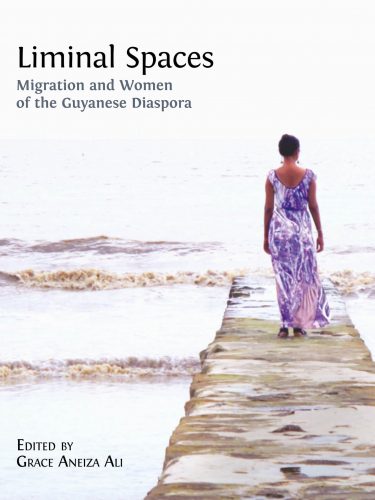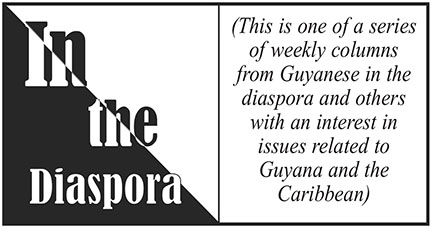By Grace Aneiza Ali
Guyanese-born Grace Aneiza Ali is a Curator and an Assistant Professor and Provost Fellow in the Department of Art & Public Policy at the Tisch School of the Arts at New York University. Ali’s curatorial research practice centers on socially engaged art practices, global contemporary art, and art of the Caribbean Diaspora, with a focus on her homeland Guyana. She serves as Curator-at-Large for the Caribbean Cultural Center in New York. She is Founder and Curator of Guyana Modern, an online platform for contemporary arts and culture of Guyana and Founder and Editorial Director of OF NOTE Magazine—an award-winning nonprofit arts journalism initiative reporting on the intersection of art and activism. Her recent book, Liminal Spaces: Migration and Women of the Guyanese Diaspora (Cambridge, UK: Open Book Publishers, 2020) explores the art and migration narratives of women of Guyanese heritage. Its open access edition is freely available to read and download at https://www.openbookpublishers.com/product/1208.
Editor’s Note:
On Wednesday, December 2, 6 pm EST, join the contributors from Liminal Spaces: Migration and Women of the Guyanese Diaspora (at bit.ly/liminalzoom) for an online conversation exploring the Guyanese-Canadian narratives of migration and the role of art in telling women’s migration stories featured in the new book. Co-sponsored by the Women and Gender Studies Institute and Caribbean Studies at New College, the University of Toronto, and the Centre for Research on Latin America and the Caribbean at York University.
 In 1995, my mother, father, older brother, younger sister, and I migrated from Guyana to the United States. We became part of what seemed like a mythical diaspora. It is estimated that more than one million Guyanese citizens now live in global metropolises like London, Toronto, and New York City, where they are the fifth largest immigrant group.
In 1995, my mother, father, older brother, younger sister, and I migrated from Guyana to the United States. We became part of what seemed like a mythical diaspora. It is estimated that more than one million Guyanese citizens now live in global metropolises like London, Toronto, and New York City, where they are the fifth largest immigrant group.
One of the most defining movements of the twenty-first century is global migration. Few of us remain untouched by its sweeping narrative. For the past fifty years, women have been a driving force in migration from Guyana as the United Kingdom, United States, and Canada looked to the Caribbean as a source for blue collar, domestic, clerical, and healthcare workers. And more recently, a growing number of women are migrating independently, becoming the breadwinners for their families. For those who leave one place for another, impelled by choice or trauma, remaining connected to a homeland is at once beautiful, fraught, disruptive, and evolving. In tandem, the new edited collection Liminal Spaces: Migration and Women of the Guyanese Diaspora gathers fifteen women of Guyanese heritage to explore their relationship to migration through the literary and visual art forms of memoir, creative non-fiction, poetry, photography, curatorial and art essays. These women—Khadija Benn, Sandra Brewster, Erika DeFreitas, Ingrid Griffith, Natalie Hopkinson, Serena Hopkinson, Dominique Hunter, Maria del Pilar Kaladeen, Maya Mackrandilal, Suchitra Mattai, Christie Neptune, Grace Nichols, Keisha Scarville, Michelle Joan Wilkinson, and myself—are artists, activists, scholars, teachers, photographers, poets, writers, playwrights, performers, journalists, and curators.
The book’s title, Liminal Spaces, encapsulates how these women examine the notion of homeland as both fixed and unfixed, a constantly shifting idea or memory, and a physical place and psychic space. Their stories reflect the ways in which Guyanese women bear witness to what drives them from their homeland as well as what keeps them emotionally and psychically tethered. Collectively, these narratives reinforce the notion these women remake, reinvent, and rebuild their lives, as many times as needed. The women in Liminal Spaces represent two spectrums of the migration arc: the ones who leave and the ones who are left. Some have stayed rooted in Guyana even as they watched their loved ones leave, year after year, for both neighboring and far-off lands. Some, although born in Guyana, maintain the rituals and traditions on the diasporic soils they now call home. Some return to Guyana often, and some rarely. Some never.
Conceived as a visual exhibition on the page, the fifteen contributors’ essays and artworks in Liminal Spaces are curated as a four-part journey—one that allows the reader to trace the migration path of Guyanese women from their motherlands, to their moment of departure, to their arrival on diasporic soils, to their reunion with Guyana, and all that flows in between.
‘Part I: Mothering Lands’ engages the tensions between motherland, the place of birth; and otherland, the space of othering. The essays take us through the voyages undertaken by mothers born in Guyana and their daughters born in the diaspora. Artists Keisha Scarville (United States) and Erika DeFreitas (Canada) and journalist Natalie Hopkinson with her mother Serena Hopkinson (Canada/United States) reveal how their mother-daughter relationships serve as a metaphor for their relationship with Guyana—a space frequently wrestled with as a mythical motherland.
In Part II, there are two spectrums of the migration arc: the ones who leave and the ones who are left. Yet, too often the narratives of the latter are constantly eclipsed. ‘The Ones Who Leave . . . The Ones Who Are Left’ counters the discourse and creative representations on migration that are overwhelmingly focused on the ones who leave. Through travelogue, memoir, art, and photography essays, I, Grace Aneiza Ali (United States), Dominique Hunter (Guyana), Khadija Benn (Guyana), and Ingrid Griffith (United States), center the stories of those who remain.
‘Part III: Transitions’ explores how Guyanese women unfold a life in a past land to construct a life in a new land; how they are made, unmade, and remade again. Poet Grace Nichols (United Kingdom) and visual artists Suchitra Mattai (United States), Christie Neptune (United States), and Sandra Brewster (Canada), detail the transition from citizen to immigrant. Their stories implore us to ponder: How do we hold steadfast to our dreams, when in order to survive we must diminish parts of the self? Revealed throughout these essays is a commitment to use their artistic practices as spaces for Guyanese women to speak, to be heard, and to be seen.
For those of us who have left one country for another, how do we return and how do we stay connected? What tangible things do we cling to? In ‘Part IV: Returns, Reunions, and Rituals,’ Michelle Joan Wilkinson (United States), Maria del Pilar Kaladeen (United Kingdom), and Maya Mackrandilal (United States) write about their returns to Guyana and the ways in which they are tethered to the houses, lands, and sacred heirlooms embedded within their family legacies. They explore how daughters of immigrants rekindle, restore, and repair frayed bonds and illuminate how we lose, rediscover, and reunite with a place.
Liminal Spaces traces seven seminal decades of Guyana’s history, offering a portrait of a colonial and postcolonial nation continuously evolving. The fifteen intergenerational cohort of voices range from women in their twenties to their seventies. For some women in this book who were born in British-ruled Guyana, bearing witness to the tumultuous birth of an independent nation and a simultaneous struggle to shirk a colonial past catalyzed their departures. The younger women, who have only known their homeland as an independent nation, still made the difficult decision to leave it. Other women who contributed to this collection have never lived in Guyana and connect only through their parents’ migration narratives. As first-generation citizens of the United States, United Kingdom, and Canada, they grapple with what survives and what is mourned once their Guyanese-born parents, their direct ties to Guyana, are gone. Some of these women once lived in Guyana, and later migrated to the country’s largest diasporic cities of New York, Toronto, and London. All in all, Liminal Spaces centers the narratives of grandmothers, mothers and daughters, immigrants and citizens—women who have labored for their country, women who are in service to a vision of what Guyanese women can and ought to be in the world.
Guyana’s legacy of migration mirrors the broader emergence of Caribbean people around the globe. The narratives featured in Liminal Spaces counter a legacy of absence and invisibility of Guyanese women’s stories. This collection—the first of its kind—is devoted entirely to the voices of women from Guyana and its expansive diaspora. Although the contributors share experiences specific to Guyana, their stories speak to migration as the defining movement of our twenty-first-century world and the tensions between place and placeless-ness, nationality and belonging, immigrant and citizen. Etched throughout the book’s literary and visual narratives is the grit, agency, and artistry required of women around the world who embark on a new life in a new land or watch the ones they love do so. Within these beautiful, disruptive stories lies a simple truth: there is no single story about migration. Rather, the act of migration is infinite, full of arrivals, departures, returns, absences, and reunions.










